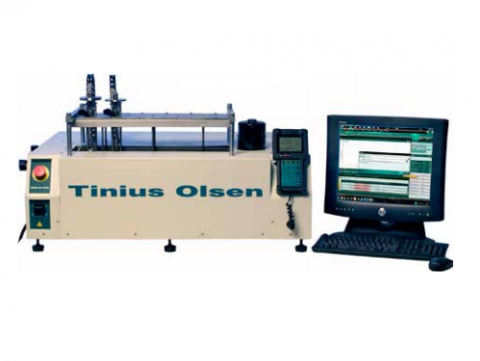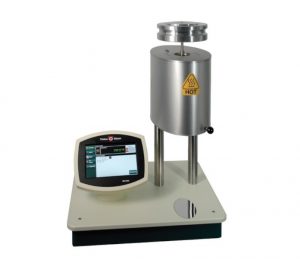HIGHLIGHTS
Conforms to ISO 75, ISO 306, ASTM D648, and ASTM D1525
Fully automatic control of entire test cycle
Bath has port with an exhaust fan to remove interior oil fumes
Automatic correction for thermal expansion of test frames
Built-in heat exchanger on the 603 for rapid system cool down
Pneumatic station lift for easy specimen insertion and removal
Built-in specimen basket to catch any dislodged specimens
Air bearing-guided loading rods for virtually friction-free load application
Electronic transducers integrated into the loading rod assemblies for 0.001 mm resolution of deflection or penetration
Loading nose and rod assemblies provide 76 grams nominal load for ISO 75 ‘flatwise’ deflection temperature tests on 4 mm x 10 mm specimens at 0.45 Mpa stress
Accessories available include additional test stations, deflection temperature loading noses, Vicat loading noses and needles, weights, 64 mm span supports for ‘flatwise’ deflection temperature testing (the stations are predrilled to accept these supports)
| 603 | 303 | ||
| Maximum number of stations | 6 | 3 | |
| Temperature range | ° C | 23-300 | |
| Temperature ramp | ° C | 50° or 120° per hou | |
| Temperature display resolution | ° C | 0.1 | |
| Temperature sensor | Platinum RTD located adjacent to the load application point at each station | ||
| Deflection/penetration measurement | LVDT | ||
| Deflection/penetration display resolution | mm | 0.001 | |
| Cooldown rate | Max. of 20o above cooling water temp. in 20 minutes | Max. of 20o above cooling water temp. in 30 minutes | |
| Temperature safety limit | Independent dual systems using thermostatic switch in bath and keypad selectable software limiting | ||
| Dimensions (WxDxH) | mm | 1067 x 762 x 572 | 813 x 635 x 585 |
| in | 42 x 30 x 22.5 | 32 x 25 x 23 | |
| Weight | kg | 132 | 87 |
| lb | 290 | 190 | |
| Required utilities | Heat transfer medium | 18 liters (4.8 US gallons) min | 11 liters (2.9 US gallons) |
| Water | Water supply for cooldown | ||
| Clean air | Dry air filtered to 50 microns at 40psi (2.7 bar) min | ||
| Power | 220 +/- 10%, 50/60Hz, 1 phase, 4.5kW | ||
Models 603 HDTM and 303 HDTM are the latest generation of Tinius Olsen’s digitally controlled Automatic Deflection Temperature/Vicat test equipment with an automated testing sequence that proceeds according to user defined control and configuration parameters.
The basic model 603 HDTM includes a six-station bath, two test stations and a handheld terminal. Up to four more stations can be added and each test frame can be configured with optional accessories for either Vicat or deflection temperature testing, including both 100mm edgewise and 64mm flatwise deflection temperature, as well as the 4in span test. Additionally, the 603 HDTM is ready to be linked to Tinius Olsen’s Horizon software so that the PC can configure the controller, collect the test data, generate a test report and save the results.
The 303 HDTM shares these same features of the 603 HDTM, however it has a maximum of three stations.
On both machines, all test stations are pneumatically raised from the bath at the touch of a button on the handheld terminal, allowing easy placement of the test specimens. Once the specimens are loaded into the respective test positions, all the stations are lowered collectively into the oil bath by pneumatic pistons and the test can start.
The start can be initiated by either the handheld terminal or directly from a PC running Tinius Olsen’s Horizon software. Once started, the test is completely automatic and is performed according to the user defined program. Upon test completion, power to the heater is
removed and the cooling cycle is initiated.
Test parameters are entered through the numeric keypad on the handheld terminal. Entries for each station include test type, deflection/penetration, span, specimen dimensions, and stress or force. Starting temperature, soak time, maximum temperature and rate of temperature rise are also entered for control of the bath unit. These configurations are stored and may be used for future tests.
The 603 HDTM has a built-in heat exchanger so that a rapid cooldown is automatically initiated once the test is complete. Using regular mains water, the temperature of the silicon oil can be reduced from a maximum of 300°C to 20° above the water inlet temperature in approximately 20 minutes.
Once the cooling cycle is complete, all test stations can be collectively raised, allowing easy removal of tested samples. In the event that a specimen is dislodged during the course of the test, it is safely caught in the specimen basket, keeping the heat transfer medium as clean as possible.
The handheld terminal also shows a continuous display of temperature and deflection/penetration for each station throughout the test.
















































Reviews
There are no reviews yet.